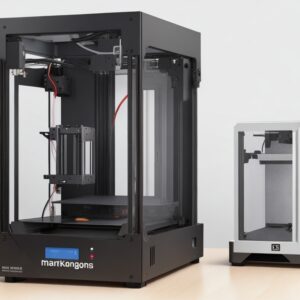If you’re considering purchasing a Markforged 3D printer, you are looking at a brand that is a leader in industrial 3D printing technology, particularly known for its capability to produce strong, functional parts. They offer a range of printers tailored to different needs, including desktop models for engineering-grade plastic parts and industrial systems for manufacturing metal components. Here’s a detailed overview focusing on their composite 3D printers.
Design

The design of Markforged 3D printers reflects a sophistication that aligns with professional environments, signaling that these devices are engineered for performance and reliability. One of the key design elements is the enclosed build chamber found in models across their product range. This feature is important as it serves multiple purposes: first, it helps in regulating the temperature within the print area, minimizing the effects of ambient temperature fluctuations which could otherwise negatively impact the quality of the print. Second, the enclosure acts as a safety barrier, reducing noise and containing any potential particulate emissions, making these printers suitable for use in both office spaces and on the shop floor.
The chassis of Markforged printers is typically constructed from high-quality aluminum, contributing to the machine’s overall sturdiness and stability. Using aluminum not only ensures the printer is lightweight and corrosion-resistant but also helps maintain a rigid framework that reduces vibrations during printing—a critical factor for achieving precise and accurate prints. This solid construction facilitates consistent performance over extended periods and under demanding workloads, which is critical for industrial applications where downtime can be costly.
Attention to detail is apparent in the arrangement of components within Markforged printers. Cable management is usually neat, and access points for maintenance and material loading are designed to be user-friendly. The printers often feature intuitive touch screen interfaces that allow operators to interact seamlessly with the machine, managing print jobs and monitoring progress with ease. These interfaces are complemented by the printers’ sleek and utilitarian appearance, with a minimalist and modern appeal that wouldn’t be out of place next to other high-end professional equipment.
The design of the print bed in Markforged printers, which is often a kinematic bed, allows for quick removal and easy leveling. This innovative approach reduces setup time, enabling users to commence print jobs with minimal delay and fuss.
Markforged printers’ design exudes a sense of purpose, focusing on delivering high-quality prints while ensuring ease of use, reliability, and safety. This design philosophy not only enhances the functionality of the printers but also contributes to an aesthetically pleasing product that businesses would be proud to display and utilize within their operations.
Print Quality
One of the hallmark features of Markforged printers is their exceptional print quality. The printers are engineered to produce parts with excellent surface finish and high precision. This is partly due to the printers’ robust hardware and the sophisticated software algorithms that control the printing process.
The unique selling point for Markforged is their Continuous Fiber Fabrication (CFF) technology, which allows for the reinforcement of parts with continuous strands of fiber such as carbon fiber, fiberglass, or Kevlar. This technology enables printed parts to have a high strength-to-weight ratio, often comparable to metal.
Print Speed
The print speed of Markforged printers is optimized for producing parts with high strength and accuracy. While not the fastest on the market, the speed is competitive within the space of composite and industrial 3D printers. The exact print speed can vary depending on the part’s complexity, the materials used, and the layer height chosen for the print.
Material Options
Markforged is known for their Onyx series of materials, which is a blend of nylon and micro-carbon fibers, producing parts with excellent strength and thermal stability. Their printers can reinforce parts with continuous fibers like carbon fiber, fiberglass, and Kevlar, providing metal-strength to 3D printed components.
Software
Markforged printers are supported by their proprietary Eiger software, which is cloud-based and very user-friendly. Eiger allows for easy management of printing settings and provides an intuitive interface for laying out fiber reinforcements. It is also designed for collaboration and can be accessed from anywhere, making it simple to share projects between teams or locations.
Price
The price for Markforged 3D printers varies substantially based on the model and capabilities:
Desktop models like the Onyx One start at around $5,000, which is accessible for small to medium-sized businesses or departments within larger organizations.
Professional series printers, including those capable of continuous fiber reinforcement, can range from approximately $13,000 for the Onyx Pro to over $32,000 for the Mark Two.
The Metal X system, which can fabricate metal parts, is significantly higher-priced, usually starting upwards of $100,000.

